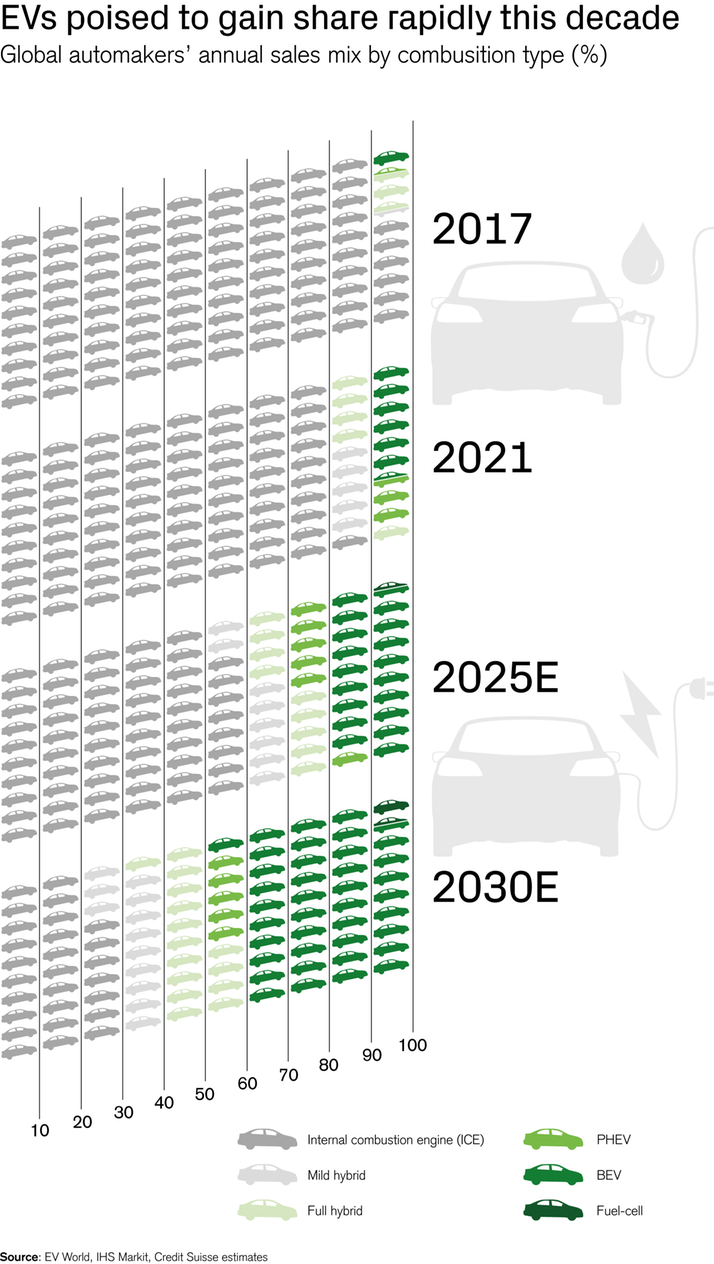The International Energy Agency (IEA) envisages that global carbon emissions will need to reach net-zero by 2050 to limit global warming. Industries can take action by switching to renewable energy sources and using carbon capture technologies to achieve this goal
The transportation sector, as a large consumer of fossil fuels, contributes significantly to global greenhouse gas emissions. Governments in the USA and Europe are poised to increase expenditures on the energy transition, transportation, and communications infrastructure. For instance, materials used in construction are being replaced by new renewable and sustainable cement and concrete which help absorb carbon emissions. Additionally, the popularity of electric vehicles (EVs) is steadily growing. We predict EVs will represent 45 percent of global annual car sales by 2030.
How green are electric vehicles?
One of the factors that determine whether an electric car is eco-friendly is the power source it uses. Internal combustion engine vehicles use fossil fuels and produce high levels of greenhouse gas emissions. In contrast, EVs can use renewable sources of electricity, and rechargeable lithium-ion batteries; their carbon footprint will thus be lower over their lifetime.
For an EV to minimise its carbon footprint, the renewable energy source to power the vehicle is not the only factor that matters. The raw materials used in the production of the vehicles and batteries are equally important. Most auto companies are taking robust action and aim to go all-electric in this decade or next. As a result, the supply chains of semiconductors, batteries, lithium, nickel, graphite, cathode, and separators are impacted.
In 2021, global EV sales reached 6.7 million, of which 4.8 million were battery electric vehicles (BEVs) and 1.9 million were plug-in hybrid electric vehicles (PHEVs). The growing demand for electric cars will result in the need for charging stations. Bloomberg New Energy Finance (BNEF) estimates that around 300 million charging stations will be required globally by 2040.
Read more: Climate Change Is Here, and Now the Fight Is Personal

Renewable energy for electricity generation
Electricity plays a part in each step of the production, manufacturing, and use of EVs. Hence, it should be generated from sustainable and renewable sources to limit emissions. According to the IEA, there was a 6 percent increase in global demand for electricity in 2021. Although electricity production from renewable and environmentally friendly sources has grown, coal-fired electricity production has still soared. Given that the IEA’s so-called “Net Zero Emissions by 2050” scenario (NZE) requires much faster electrification of all industry sectors, it expects electricity demand to more than double by 2040.
The European Union has proposed a new green labelling system to help guide private investment in activities that will help achieve climate neutrality over the next three decades. The proposal, which needs to be reviewed by the European Parliament and Council, aims to classify both nuclear energy and natural gas as transitional fuels as of January 1, 2023. The labelling system defines the standards for new gas power plants and categorizes certain forms of natural gas as "green." This will have global ramifications for new investments in both energy sources.
However, it will take years to generate additional nuclear energy due to the time required to obtain approval and construct new nuclear plants. Moreover, renewable energy sources such as wind and solar power are still less reliable sources of electricity. These challenges will result in the power generation sector being heavily dependent on gas as the fuel of choice for the next decade.
The Credit Suisse Supertrends 2022 report predicts that governments and businesses will ramp up their efforts to introduce new technologies such as using environmentally friendly construction materials in infrastructure projects and electric vehicles for transportation. Download the report to find out more.
